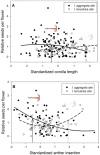Pollinator and habitat-mediated selection as potential contributors to ecological speciation in two closely related species
- PMID: 38525033
- PMCID: PMC10959478
- DOI: 10.1093/evlett/qrad060
Pollinator and habitat-mediated selection as potential contributors to ecological speciation in two closely related species
Abstract
In ecological speciation, incipient species diverge due to natural selection that is ecologically based. In flowering plants, different pollinators could mediate that selection (pollinator-mediated divergent selection) or other features of the environment that differ between habitats of 2 species could do so (environment-mediated divergent selection). Although these mechanisms are well understood, they have received little rigorous testing, as few studies of divergent selection across sites of closely related species include both floral traits that influence pollination and vegetative traits that influence survival. This study employed common gardens in sites of the 2 parental species and a hybrid site, each containing advanced generation hybrids along with the parental species, to test these forms of ecological speciation in plants of the genus Ipomopsis. A total of 3 vegetative traits (specific leaf area, leaf trichomes, and photosynthetic water-use efficiency) and 5 floral traits (corolla length and width, anther insertion, petal color, and nectar production) were analyzed for impacts on fitness components (survival to flowering and seeds per flower, respectively). These traits exhibited strong clines across the elevational gradient in the hybrid zone, with narrower clines in theory reflecting stronger selection or higher genetic variance. Plants with long corollas and inserted anthers had higher seeds per flower at the Ipomopsis tenuituba site, whereas selection favored the reverse condition at the Ipomopsis aggregata site, a signature of divergent selection. In contrast, no divergent selection due to variation in survival was detected on any vegetative trait. Selection within the hybrid zone most closely resembled selection within the I. aggregata site. Across traits, the strength of divergent selection was not significantly correlated with width of the cline, which was better predicted by evolvability (standardized genetic variance). These results support the role of pollinator-mediated divergent selection in ecological speciation and illustrate the importance of genetic variance in determining divergence across hybrid zones.
Keywords: cline; divergent selection; floral traits; pollination; speciation; vegetative traits.
© The Author(s) 2023. Published by Oxford University Press on behalf of The Society for the Study of Evolution (SSE) and European Society for Evolutionary Biology (ESEN).
Figures



Similar articles
-
Clines in traits compared over two decades in a plant hybrid zone.Ann Bot. 2018 Aug 1;122(2):315-324. doi: 10.1093/aob/mcy072. Ann Bot. 2018. PMID: 29800076 Free PMC article.
-
Genetic and spatial variation in vegetative and floral traits across a hybrid zone.Am J Bot. 2022 Nov;109(11):1780-1793. doi: 10.1002/ajb2.16067. Epub 2022 Oct 4. Am J Bot. 2022. PMID: 36193908 Free PMC article.
-
Genetic Mapping Reveals an Anthocyanin Biosynthesis Pathway Gene Potentially Influencing Evolutionary Divergence between Two Subspecies of Scarlet Gilia (Ipomopsis aggregata).Mol Biol Evol. 2018 Apr 1;35(4):807-822. doi: 10.1093/molbev/msx318. Mol Biol Evol. 2018. PMID: 29253197
-
Adaptive differentiation in floral traits in the presence of high gene flow in scarlet gilia (Ipomopsis aggregata).Mol Ecol. 2016 Dec;25(23):5862-5875. doi: 10.1111/mec.13752. Epub 2016 Aug 8. Mol Ecol. 2016. PMID: 27392816
-
ADAPTIVE SIGNIFICANCE OF FLOWER COLOR AND INTER-TRAIT CORRELATIONS IN AN IPOMOPSIS HYBRID ZONE.Evolution. 1998 Oct;52(5):1293-1303. doi: 10.1111/j.1558-5646.1998.tb02011.x. Evolution. 1998. PMID: 28565388
Cited by
-
Fluctuating selection in a monkeyflower hybrid zone.Evol Lett. 2024 Sep 26;9(1):77-88. doi: 10.1093/evlett/qrae050. eCollection 2025 Feb. Evol Lett. 2024. PMID: 39906586 Free PMC article.
-
Natural selection on floral volatiles and other traits can change with snowmelt timing and summer precipitation.New Phytol. 2025 Jan;245(1):332-346. doi: 10.1111/nph.20157. Epub 2024 Sep 27. New Phytol. 2025. PMID: 39329349 Free PMC article.
-
Fluctuating selection in a Monkeyflower hybrid zone.bioRxiv [Preprint]. 2024 Jun 17:2024.06.14.599085. doi: 10.1101/2024.06.14.599085. bioRxiv. 2024. Update in: Evol Lett. 2024 Sep 26;9(1):77-88. doi: 10.1093/evlett/qrae050. PMID: 38948721 Free PMC article. Updated. Preprint.
References
-
- Arnold, M. (1997). Natural hybridization and evolution. Oxford University Pres; s.
-
- Barton, N., & Hewitt, G. (1985). Analysis of hybrid zones. Annual Review of Ecology and Systematics, 16, 113–148.

